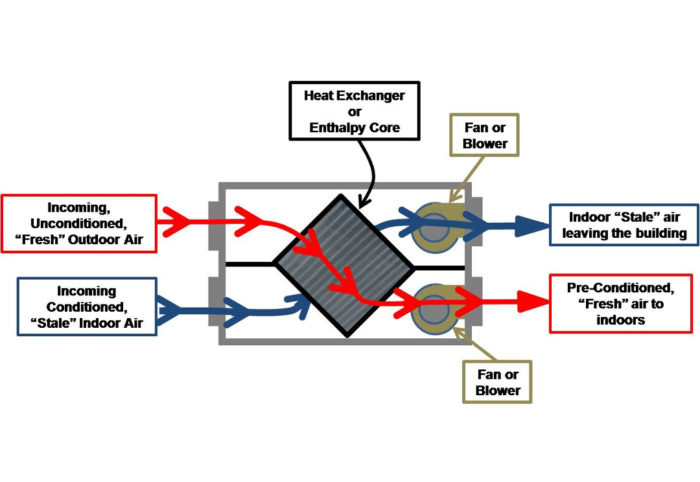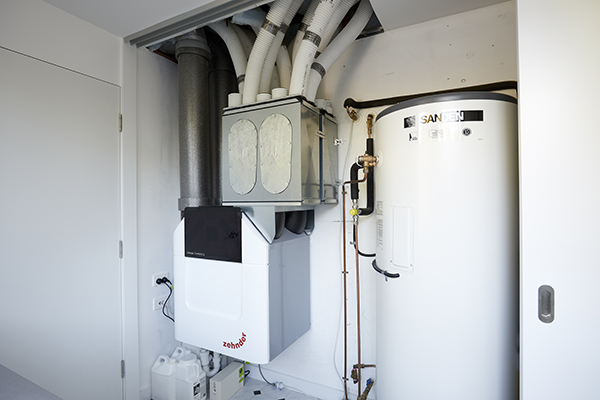7 Clues You Should Consider HRV in Your Home
Revealing the Key Benefits and Uses of Heat Recovery Ventilation in Lasting Design
Heat Recovery Ventilation (HRV) systems play a necessary function in sustainable layout. They assist in a continuous exchange of stagnant interior air with fresh outside air, significantly improving interior air quality. Furthermore, HRVs add to energy performance by recovering warm from exhausted air, which can lower utility expenses. Understanding the complex benefits and applications of HRVs reveals their significance in contemporary architecture. What various other advantages do these systems use in the pursuit of sustainability?
Comprehending Heat Recovery Ventilation Systems
Heat recovery ventilation (HRV) systems are created to boost indoor air quality while decreasing energy loss. These systems make use of a mechanical ventilation method to exchange stagnant interior air with fresh exterior air, ensuring a constant supply of clean air. By catching warmth from the exhaust air, HRVs precondition incoming air, decreasing the demand on heating and cooling systems. This procedure not just boosts thermal comfort but likewise contributes to energy efficiency in property and business buildings. In addition, HRV systems help control moisture levels and decrease indoor toxins, advertising a healthier living environment. Their tactical application is important for accomplishing sustainable layout objectives, as they supply an equilibrium between energy conservation and resident wellness.
Just How HRV Systems Work
While numerous may recognize with air flow systems, understanding how heat recovery ventilation (HRV) systems operate is vital for appreciating their advantages. HRV systems operate by trading stagnant indoor air with fresh outdoor air while transferring warm in between the 2 streams. This procedure takes place in a heat exchanger, where warm from the outbound air warms the inbound air during chillier months, minimizing energy loss. Conversely, in warmer months, the system can cool incoming air using the cooler outgoing air. HRVs are equipped with followers to promote air flow and filters to eliminate particulates, making certain a continual, well balanced ventilation process. This cutting-edge layout not just boosts energy efficiency yet also adds to keeping a comfortable interior environment.
Enhancing Indoor Air Quality
Interior air high quality can greatly affect health and wellness, making effective air flow essential in modern homes. Heat Recovery Ventilation (HRV) systems play a crucial duty in maintaining interior air top quality by constantly trading stale indoor air with fresh outside air. This procedure not only lowers airborne pollutants however likewise decreases moisture degrees, which can lead to mold growth and breathing issues. HRV systems filter inbound air, removing allergens and particulates, thus offering a healthier living setting. Furthermore, these systems aid remove smells and unpredictable organic compounds (VOCs) commonly discovered in home products. By making certain a consistent flow of tidy air, HRV systems add to an overall enhanced indoor atmosphere, advertising comfort and well-being for occupants.
Power Efficiency and Cost Cost Savings
Power performance sticks out as a significant benefit of Heat Recovery Ventilation (HRV) systems. By recording and reusing the warmth from worn down interior air, HRVs minimize the power needed for home heating incoming fresh air, causing lowered energy usage. This performance converts into reduced energy expenses, providing considerable cost savings for home owners and businesses alike. Additionally, HRV systems frequently receive energy effectiveness motivations and discounts, further enhancing their monetary charm. In time, the initial financial investment in HRV modern technology can cause a desirable roi with decreased power expenditures. The assimilation of HRV systems not just promotes lasting layout but additionally gives a sensible option for achieving lasting power cost savings and financial benefits.
Environmental Advantages of HRV

A wide range of environmental benefits develops from the execution of Heat Recovery Ventilation (HRV) systems. By successfully moving warm from exhaust air to incoming fresh air, HRVs substantially lower the energy needed for home heating and cooling areas. This energy performance equates to lower greenhouse gas exhausts, adding to a reduction in the overall carbon impact of buildings. In addition, HRV systems enhance indoor air top quality by constantly distributing fresh air, thus lowering the concentration of indoor contaminants and allergens. The decrease in energy intake help in preserving natural resources, making HRVs an important component of lasting style. Generally, the ecological advantages of HRVs play a crucial duty in advertising a much healthier world and promoting eco-friendly structure techniques.
Versatile Applications in Modern Architecture
Heat recovery ventilation (HRV) systems are significantly being integrated into both property and commercial architectural projects. In household settings, HRVs improve interior air quality while taking full advantage of power efficiency. On the other hand, in commercial rooms, these systems enhance ventilation strategies, demonstrating their versatility in modern building applications.
Residential Projects Integration
While modern style progressively emphasizes sustainability, the combination of heat recovery air flow systems in domestic jobs has actually become a functional remedy for boosting interior air top quality and power efficiency. These systems effectively move warm from exhaust air to incoming fresh air, reducing energy loss and reducing heating or cooling down needs. In new builds and retrofits alike, heat recovery ventilation can be seamlessly included, giving homeowners with a much healthier living setting while decreasing energy expenses. Furthermore, with enhancing awareness of environmental influences, even more designers and home builders are recognizing the long-term benefits of these systems. Because of this, warmth recuperation air flow has actually ended up being an essential component of lasting household visit this website style, showcasing flexibility and commitment to environmentally friendly practices.
Business Areas Optimization
As contemporary commercial rooms develop to fulfill the needs of sustainability and efficiency, the application of heat recuperation ventilation systems arises as a crucial strategy for optimizing interior environments. These systems help with the exchange of stagnant indoor air with fresh exterior air while recovering heat, substantially minimizing energy usage. This not only improves convenience for passengers but likewise aids in lowering functional costs. Flexible applications can be observed in workplaces, retail spaces, and schools, where air quality and temperature level control are extremely important. Furthermore, incorporating heat healing air flow aligns with eco-friendly structure qualifications, further advertising environmental obligation. Ultimately, adopting such systems in industrial design not just adds to sustainability goals yet additionally fosters much healthier, more productive spaces for individuals.
Incorporating HRV Into Sustainable Design Practices
Integrating heat healing ventilation (HRV) systems into sustainable design practices provides considerable advantages in energy effectiveness and indoor air quality. By utilizing HRV, designers can develop cost-effective options that not just minimize energy consumption but additionally boost the general comfort of interior atmospheres. This alignment with sustainability objectives settings HRV as a necessary component in contemporary building methods.
Power Effectiveness Improvement
By incorporating warm recovery air flow (HRV) systems right into sustainable style techniques, architects and builders can substantially enhance power efficiency in contemporary buildings. HRV systems work by catching warmth from outgoing stale air and transferring it to incoming fresh air, lessening the power required for heating or cooling down indoor areas. This process not only decreases reliance on typical HVAC systems but also reduces general energy usage. On top of that, HRV systems can assist maintain a constant indoor temperature level, minimizing peak power demands. By incorporating these systems, buildings can accomplish significant reductions in energy costs and carbon impacts, straightening with sustainability objectives. Eventually, HRV technology stands for a practical option for boosting energy efficiency in the constructed setting, advertising more accountable source use.
Indoor Air Top Quality Enhancement
Just how can heat recuperation air flow (HRV) systems add to exceptional interior air top quality in modern-day buildings? HRV systems effectively exchange stale indoor air with fresh outside air while recouping heat energy, decreasing temperature level fluctuations. This process minimizes the focus of indoor contaminants, such as volatile natural compounds (VOCs), irritants, and wetness, which can deteriorate air high quality and impact occupant wellness. By maintaining suitable humidity degrees and making certain a continuous supply of clean air, HRVs aid produce a healthier indoor atmosphere. On top of that, these systems can be incorporated right into view it now lasting style methods, advertising power performance together with improved air quality. HRV Heat Recovery Ventilation. As a result, HRV modern technology plays a vital role ahead of time overall occupant comfort and wellness in modern building layouts
Affordable Design Solutions

Regularly Asked Concerns
What Maintenance Is Needed for Heat Recovery Ventilation Systems?

Maintenance for heat healing ventilation systems usually entails routine filter substitutes, cleaning of warm exchangers, inspection of followers and ducts, and making sure correct water drainage. These jobs assist keep effectiveness and lengthen the system's life expectancy with time.
Can HRV Solutions Be Installed in Existing Buildings?
Heat recovery ventilation systems can without a doubt be installed in existing buildings. HRV Heat Recovery Ventilation. Retrofitting calls for careful preparation and evaluation of the structure's format, guaranteeing compatibility with present systems while making best use of energy efficiency and indoor air high quality
Just How Do HRV Solution Impact Noise Degrees Inside?
HRV systems can affect indoor noise levels by introducing noise from exterior resources via air flow. Nonetheless, premium installments typically include sound-dampening attributes, minimizing noise impact while offering efficient air exchange and preserving comfort inside your home.
Exist Any Kind Of Disadvantages to Making Use Of HRV Solutions?
The drawbacks of utilizing HRV systems consist of prospective high initial expenses, maintenance challenges, and the possibility of reduced interior air top quality if filters are sporadically transformed, which might lead to concerns with moisture levels.
Just how Do I Choose the Right HRV System for My Requirements?
Picking the right warm recovery ventilation system entails evaluating specific demands, such as building dimension, climate, and power efficiency goals. In addition, evaluating system functions, installment needs, and upkeep considerations is essential for peak efficiency and contentment.